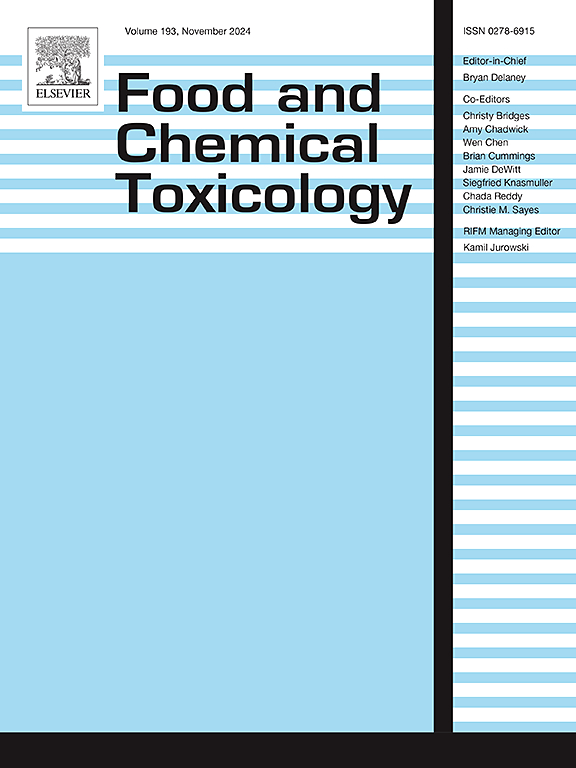Protective effects of anthocyanins on the nervous system injury caused by fluoride-induced endoplasmic reticulum stress in rats
IF 3.9
3区 医学
Q2 FOOD SCIENCE & TECHNOLOGY
引用次数: 0
Abstract
Long-term fluoride exposure can produce neurotoxicity. Anthocyanins, as antioxidants, have a certain protective effect in nerve damage. This study aimed to investigate the protective role of anthocyanins in fluoride-induced neurological damage due to endoplasmic reticulum stress (ERS). Using a fluoride-exposed Wistar rat model, we assessed learning memory capacity and pathologic and ultrastructural injury. The level of oxidative stress (OS) in vivo was detected by colorimetric method, the level of ERS was analyzed by immunohistochemistry, and the apoptosis of neuronal cells was observed by TUNEL staining. The results showed that fluoride exposure could decrease the learning and memory ability in rats, and led to histopathological and ultrastructural damage in the hippocampal CA1, CA3 and cortical regions. Fluoride exposure-induced OS in vivo, which further activates ERS, which was manifested by increased levels of ERS-related proteins GRP78, Caspase 12, and Caspase 3 in hippocampal CA1, CA3, and cortical regions, and eventually led to a significant increase in neuronal apoptosis rate. Notably, after anthocyanins treatment, pathological and ultrastructural damage was restored, the level of OS and ERS were significantly restored, and the apoptosis rate of neuronal cells was significantly reduced. In summary, as nutritional interventions, anthocyanins exert a protective role in fluoride-induced neurological injury.
花青素对氟致内质网应激大鼠神经系统损伤的保护作用。
长期接触氟化物会产生神经毒性。花青素作为抗氧化剂,对神经损伤有一定的保护作用。本研究旨在探讨花青素在氟化物引起的内质网应激(ERS)神经损伤中的保护作用。使用氟暴露Wistar大鼠模型,我们评估了学习记忆能力和病理和超微结构损伤。采用比色法检测大鼠体内氧化应激(OS)水平,免疫组织化学法检测大鼠体内ERS水平,TUNEL染色法观察神经元细胞凋亡情况。结果表明,氟暴露可导致大鼠学习记忆能力下降,海马CA1、CA3和皮质区出现组织病理学和超微结构损伤。氟暴露在体内诱导OS,进一步激活ERS,表现为海马CA1、CA3和皮质区ERS相关蛋白GRP78、Caspase 12和Caspase 3水平升高,最终导致神经元凋亡率显著升高。值得注意的是,花青素处理后,大鼠的病理和超微结构损伤得到恢复,OS和ERS水平明显恢复,神经元细胞凋亡率明显降低。综上所述,作为营养干预措施,花青素在氟化物引起的神经损伤中发挥保护作用。
本文章由计算机程序翻译,如有差异,请以英文原文为准。
求助全文
约1分钟内获得全文
求助全文
来源期刊

Food and Chemical Toxicology
工程技术-毒理学
CiteScore
10.90
自引率
4.70%
发文量
651
审稿时长
31 days
期刊介绍:
Food and Chemical Toxicology (FCT), an internationally renowned journal, that publishes original research articles and reviews on toxic effects, in animals and humans, of natural or synthetic chemicals occurring in the human environment with particular emphasis on food, drugs, and chemicals, including agricultural and industrial safety, and consumer product safety. Areas such as safety evaluation of novel foods and ingredients, biotechnologically-derived products, and nanomaterials are included in the scope of the journal. FCT also encourages submission of papers on inter-relationships between nutrition and toxicology and on in vitro techniques, particularly those fostering the 3 Rs.
The principal aim of the journal is to publish high impact, scholarly work and to serve as a multidisciplinary forum for research in toxicology. Papers submitted will be judged on the basis of scientific originality and contribution to the field, quality and subject matter. Studies should address at least one of the following:
-Adverse physiological/biochemical, or pathological changes induced by specific defined substances
-New techniques for assessing potential toxicity, including molecular biology
-Mechanisms underlying toxic phenomena
-Toxicological examinations of specific chemicals or consumer products, both those showing adverse effects and those demonstrating safety, that meet current standards of scientific acceptability.
Authors must clearly and briefly identify what novel toxic effect (s) or toxic mechanism (s) of the chemical are being reported and what their significance is in the abstract. Furthermore, sufficient doses should be included in order to provide information on NOAEL/LOAEL values.
 求助内容:
求助内容: 应助结果提醒方式:
应助结果提醒方式:


